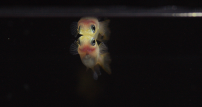Enlarge Image
Medaka fish use faces to identify different individuals
For many animals including humans, the ability to identify different individuals among their own kind is an essential ability for everyday living. Face is the most important body part for individual recognition in many animals, and faces are special in many ways. For example, in human and some other mammals, we not only look at the parts of a face (such as eyes and nose), but read the face as a whole. When we see an upside-down face, it is more difficult to recognize it because our ability to ‘read the face as a whole’ is interrupted (Face inversion effect). This special ability only occurs in faces and not in other objects.
Some fish, such as medaka (also called Japanese rice fish), can identify one individual from others. For example, female medaka like the males she has seen before. However, we do not know how they distinguish a certain male from many others.
Mu-yun Wang and her colleagues (at the University of Tokyo and Okayama University) have found that medaka use faces for individual recognition, and how fish recognizing faces may be different from non-face objects.
The researchers tested whether medaka use vision, odor or both cues to recognize mates. Moreover, the group studied which body part is used for identifying a familiar male. They also compared how fish separate two fish or two objects, in both right-side up and upside-down positions. If faces are “special” for medaka, they may not be able to recognize the upside-down faces equally well, but should show no difference between right-side up and upside-down objects. They found that medaka use both vision and olfaction to distinguish between fish, but only vision is enough. More specifically, they use faces for individual recognition. Even when they added some spots on their faces, the fish could still recognize the face-painted fish without difficulty. Fish can discriminate between two fish faces and two objects equally well, but when the faces are upside-down, it becomes more difficult to tell them apart. When discriminating between two non-face objects, medaka can perform equally good in the right-side up and the upside-down positions. This suggests that faces might be special for fish, just as humans.
This is the first study showing animals other than mammals may have special ability to recognize faces. Even with their small brain, the fish can separate different individuals apart. The findings can be important to understand how animals, including humans, recognizing faces and its evolutionary origins. We have a powerful genetic toolbox for medaka, thus we may be able to find the genes and neurons relative to face recognition.
Reference:
Authors
Mu-Yun Wang* and Hideaki Takeuchi
Title of original paper
Individual recognition and the “face inversion effect” in medaka fish ( Oryzias latipes)<
Journal
eLife 2017;6:e24728
Digital Object Identifier (DOI)
https://doi.org/10.7554/eLife.24728
Journal website
https://elifesciences.org/articles/24728
Podcast provided by eLife
https://elifesciences.org/podcast/episode41
Affiliations
The University of Tokyo and Okayama University
Department website
http://www.biol.okayama-u.ac.jp/index_e.html

